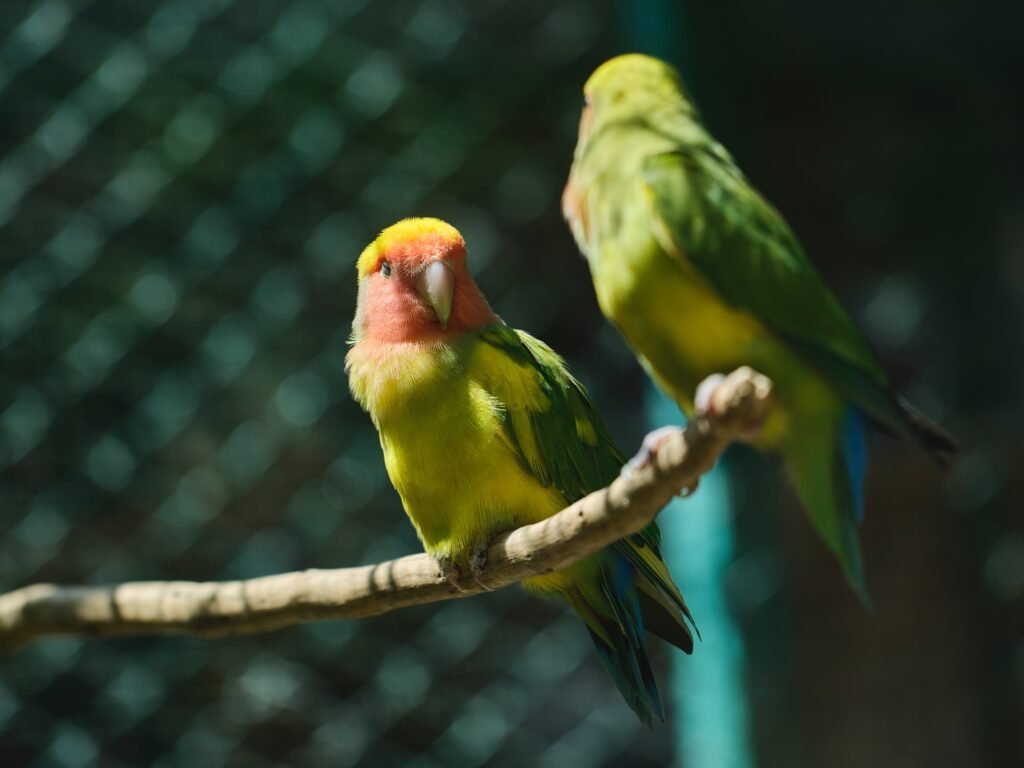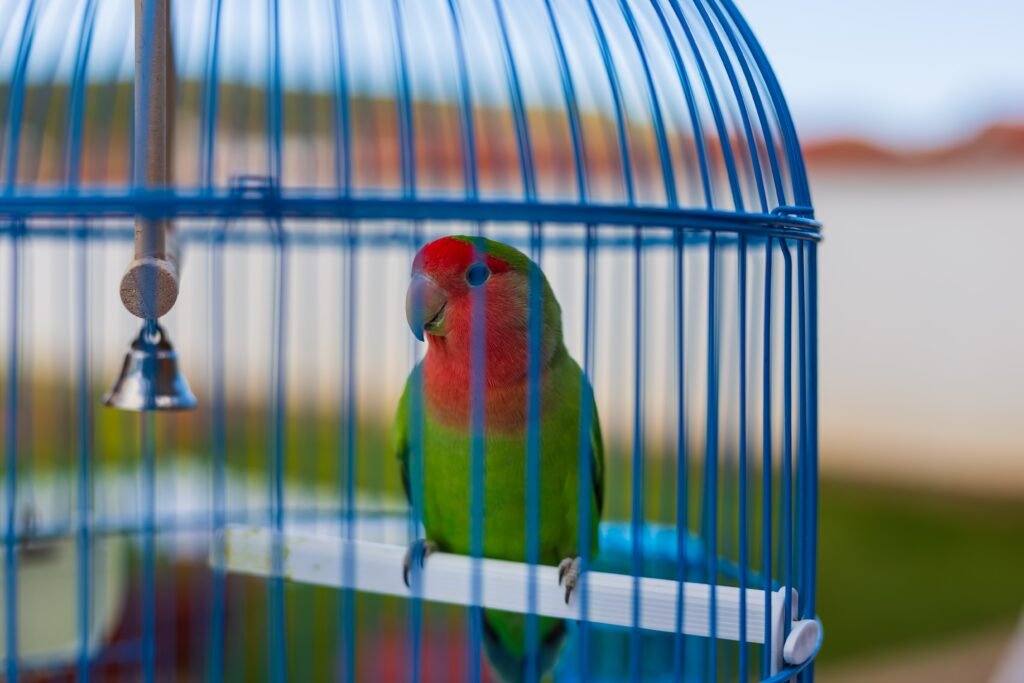Lovebirds are fascinating and captivating birds that have gained popularity due to their affectionate nature and strong bond with their human companions. These small parrots, originally from Africa, have stolen the hearts of bird enthusiasts worldwide with their vibrant colors, playful personalities, and remarkable ability to form deep emotional connections. In this article, we will delve into the concept of lovebird affection, providing valuable insights into understanding and expressing love with these delightful feathered friends.
The Nature of Lovebirds Affection
Lovebirds are highly sociable creatures that thrive on companionship and interaction. They form strong pair bonds with their mates and can also develop deep attachments with their human caregivers. Understanding the nature of lovebird affection is crucial in nurturing a strong and loving relationship with these avian companions.
- Pair Bonding
Pair bonding is a fundamental aspect of lovebirds’ social behavior. Lovebirds typically choose a mate for life and engage in various bonding behaviors to strengthen their relationship. These behaviors include preening each other’s feathers, sharing food, engaging in mutual grooming, and performing synchronized movements. These activities help solidify their bond and serve as a form of communication and affection between them.
Lovebirds’ pair bonding behaviors reflect their commitment to their partner. They establish trust and reinforce their emotional connection by engaging in activities such as preening and mutual grooming. These behaviors also strengthen their physical bond by ensuring their feathers are clean and well-maintained. Lovebirds create a sense of unity and harmony through synchronized movements, further deepening their bond.
- Human Bonding
Lovebirds have the remarkable ability to bond with their avian companions and their human caregivers. Through consistent and positive interactions, lovebirds can form deep emotional connections with their human companions, treating them as part of their flock. This unique ability demonstrates their adaptability and capacity for forming meaningful relationships beyond their species.
When lovebirds bond with humans, they often display affectionate behaviors similar to those they exhibit with their mates. They may engage in head-bobbing, regurgitate food, and even seek physical contact, such as snuggling against their caregiver’s neck or shoulder. These gestures are a testament to their trust and affection towards their human companions. Lovebirds’ ability to form bonds with humans highlights the importance of providing them with love, attention, and positive interactions to foster a strong and lasting relationship.
Expressing Love and Affection to Lovebirds
While lovebirds may express their affection uniquely, it is equally important for us as their caretakers to reciprocate and express our love and affection towards them. Here are some meaningful ways to show love and affection to your feathered friends:
- Physical Contact
Physical contact is a powerful way to bond and express love to your lovebirds. Gentle head scratches, softly stroking their feathers, and offering them a warm and secure space on your hand or shoulder can make them feel safe, loved, and cherished. Lovebirds enjoy being touched and appreciate the comfort and security it provides. By engaging in gentle physical contact, you can strengthen the bond between you and your lovebirds, fostering a sense of trust and affection.
In addition to direct physical contact, providing a comfortable environment for your lovebirds is crucial. Ensure they have a spacious cage with plenty of perches and toys for them to explore and play with. Creating a cozy and stimulating space for them will keep them entertained and promote their overall well-being. Lovebirds thrive in an environment that offers both physical comfort and mental stimulation.
- Verbal Communication
Lovebirds are highly intelligent and responsive birds, capable of recognizing and understanding human speech. Regularly engaging in verbal communication with your lovebirds through gentle and soothing words can strengthen your bond and show them your affection. Talking to your lovebirds calmly and reassuringly can provide comfort and establish a sense of companionship.
Lovebirds can mimic human speech to some extent and may even learn to repeat certain words or phrases. Encouraging their vocal abilities by speaking to them frequently can be an enjoyable and interactive way to express your love and affection. Remember to use positive and encouraging words to create a nurturing and loving environment for your lovebirds.
- Playtime and Enrichment
Ensuring a stimulating and engaging environment for your lovebirds is crucial for their mental and emotional well-being. Spend quality time playing with them, providing interactive toys, and setting up a variety of perches and swings to keep them entertained and happy. Lovebirds are naturally curious and active birds requiring mental and physical stimulation to thrive.
Engage in interactive play sessions with your lovebirds, using toys that encourage their natural behaviors, such as foraging and chewing. Rotate their toys regularly to keep their environment fresh and exciting. Additionally, consider introducing puzzle or food-dispensing toys to challenge their problem-solving skills and provide mental stimulation. Playtime strengthens the bond between you and your lovebirds and promotes their overall health and well-being.
- Healthy Diet and Care
Expressing love and affection also involves caring for your lovebirds’ physical health. Providing a balanced and nutritious diet, fresh water, regular veterinary check-ups, and a clean and comfortable living space are essential for responsible lovebird care. A healthy diet is crucial for the overall well-being of your lovebirds, ensuring that they receive the necessary nutrients to support their physical health and longevity.
Offer a variety of fresh fruits, vegetables, high-quality pellets, and occasional treats to provide a well-rounded diet for your lovebirds. Avoid feeding them foods toxic to birds, such as avocado, chocolate, caffeine, and alcohol. Clean their cage regularly to maintain a hygienic living environment and prevent the buildup of harmful bacteria. Also, regular veterinary check-ups should be scheduled to monitor their health and promptly address potential issues.
The Benefits of Lovebird Affection
Investing time and effort in understanding and expressing lovebird affection can benefit your feathered friends and yourself. Here are some of the advantages:
- Stronger Bond
By nurturing a loving and affectionate relationship with your lovebirds, you can develop a stronger bond based on trust, mutual understanding, and companionship. This bond can bring immense joy and fulfillment to both you and your birds. A strong bond ensures your lovebirds feel secure and loved, promoting their well-being and happiness.
- Emotional Well-being
Lovebirds are highly sensitive creatures that thrive on love and attention. Feeling loved and cherished makes them more likely to experience positive emotional well-being, leading to a happier, healthier, and more contented life. Expressing love and affection towards your lovebirds helps create a nurturing and positive environment contributing to their emotional well-being.
- Reduced Stress and Loneliness
For humans, interacting with lovebirds and receiving their affectionate gestures can have a calming and stress-reducing effect. Lovebirds’ playful antics, sweet chirping, and cuddly nature can alleviate loneliness and provide comfort and companionship. Spending time with your lovebirds and reciprocating their affection can bring joy and peace, reducing stress and enhancing overall well-being.
- Enhanced Understanding of Avian Behavior
By delving into the intricacies of lovebird affection, you gain a deeper understanding of avian behavior and psychology. This knowledge enhances your relationship with your lovebirds and enables you to better appreciate and care for other avian species. Understanding the unique ways lovebirds express love and affection can serve as a foundation for understanding and connecting with other birds in the future.
In conclusion, lovebird affection is a beautiful and heartwarming aspect of these delightful avian companions. Understanding and expressing love with your lovebirds can strengthen your bond, enhance their well-being, and bring immeasurable joy and fulfillment to your lives. By following the tips and suggestions in this article, you will be well on your way to building a loving and affectionate relationship with your feathered friends that will last a lifetime.
Note: Markdown format cannot be displayed on this platform as it does not support formatting.
FAQ
Q1: What are some pair bonding behaviors exhibited by lovebirds?
A1: Lovebirds engage in activities such as preening each other’s feathers, sharing food, mutual grooming, and performing synchronized movements to strengthen their bond.
Q2: Can lovebirds form deep emotional connections with humans?
A2: Yes, lovebirds can bond with their human caregivers and can display affectionate behaviors such as head-bobbing, regurgitation of food, and seeking physical contact.
Q3: How can I express love and affection to my lovebirds?
A3: You can show love and affection to your lovebirds through physical contact, verbal communication, playtime, enrichment, and providing a healthy diet and care.
Q4: What are the benefits of expressing lovebird affection?
A4: Expressing lovebird affection can result in a stronger bond, promote emotional well-being for the lovebirds and their caregivers, reduce stress and loneliness, and enhance understanding of avian behavior.
.


